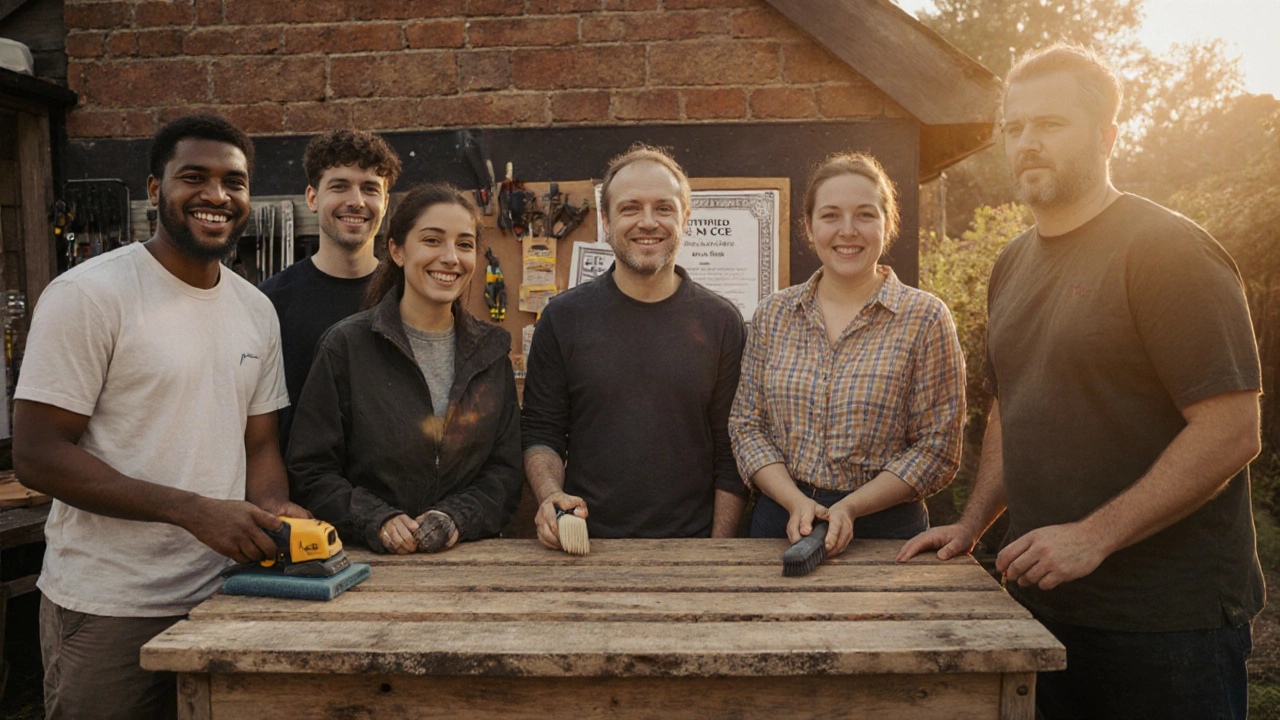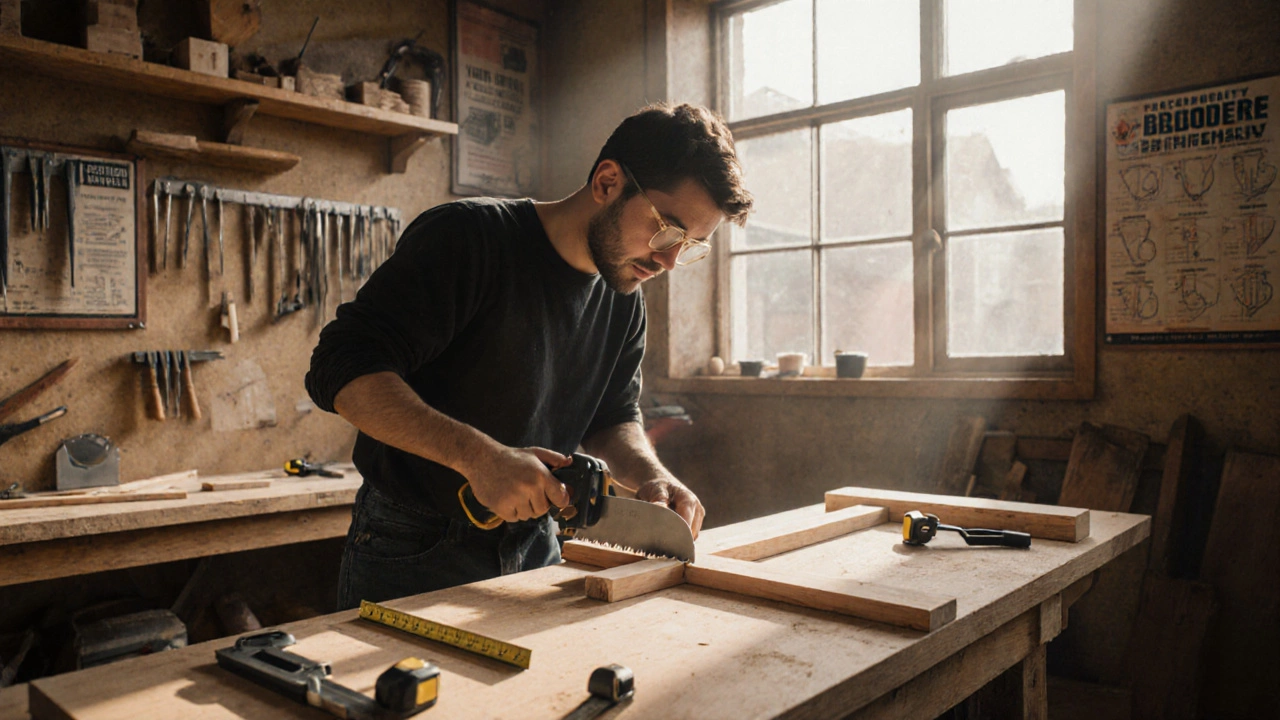Carpentry Tools Cost Calculator
Essential Tools
Choose your tool selection based on beginner essentials
Purchase Type
Cost Estimate
Article Insight: Most beginners waste money on fancy saws or expensive wood. Focus on basic, reliable brands like Stanley or DeWalt.
Tool Recommendations
- Claw Hammer: Stanley 16oz (new: £25, used: £15)
- Tape Measure: Stanley FatMax (new: £15, used: £10)
- Combination Square: 12" (new: £20, used: £12)
- Handsaw: Tenon Saw (new: £35, used: £20)
- Power Drill: Basic Cordless (new: £50, used: £35)
- Chisels: Set of 3 (new: £40, used: £25)
*Prices approximate for UK market
Most people think learning carpentry means spending years in a dusty workshop watching someone else hammer nails. That’s not true. The best way to learn carpentry isn’t by reading books or watching YouTube videos alone-it’s by doing. Real carpentry is learned with your hands, your eyes, and your mistakes. If you want to build a shelf that doesn’t wobble, fix a broken door frame, or eventually construct a deck that lasts a decade, you need to start with the right mix of structure, practice, and feedback.
Start with a clear goal
Don’t jump into building a cabinet before you know how to hold a saw properly. Ask yourself: Why do you want to learn carpentry? Is it to save money on home repairs? To build furniture for your kids? Or are you thinking about a career change? Your goal shapes your path.
If you’re fixing things around the house, focus on basic joinery, measuring, and drilling. If you want to make tables or bookshelves, you’ll need to learn about wood types, grain direction, and finishing. If you’re aiming for a trade, you’ll need certification and real-world job experience. Each path has a different starting point.
Take a structured course-not just any class
Online tutorials are helpful, but they skip the critical stuff: how to adjust a plane, how to spot a warped board, or why your chisel keeps splitting the wood. The best way to learn carpentry is through a hands-on course that gives you real tools, real wood, and real feedback.
In the UK, many local colleges and trade schools offer entry-level carpentry courses under the Vocational Training umbrella. Look for courses labeled as “Level 1 Carpentry” or “Introduction to Carpentry Skills.” These usually run 8-12 weeks, 2-3 days a week, and cost between £200 and £500. You’ll work with hand tools, power tools, and learn safety standards from certified instructors.
Don’t choose a course just because it’s cheap. Check if it’s accredited by a recognized body like City & Guilds or NCFE. These qualifications matter if you ever want to get hired as a carpenter’s assistant or apply for an apprenticeship later.
Get access to tools-without buying everything
You don’t need a $2,000 workshop to start. But you do need a few essentials: a claw hammer, a tape measure, a combination square, a handsaw, a power drill, and a set of chisels. Borrow or rent tools at first. Many community workshops, makerspaces, or even local libraries now offer tool lending programs.
Here’s what most beginners waste money on: fancy saws, expensive wood, or toolkits with 50 useless attachments. Stick to basic, reliable brands like Stanley, DeWalt, or Milwaukee. Buy one good chisel, not five cheap ones. Learn to sharpen it. A sharp tool is safer and more precise than a shiny, dull one.
Practice on scrap wood-every single day
Carpeting a room doesn’t make you a carpenter. Building a birdhouse doesn’t either. Real skill comes from repetition. Set up a small space at home-a garage corner, a shed, even a balcony-with a workbench and a vise. Keep a pile of scrap 2x4s, plywood offcuts, and old doors.
Do this every week:
- Practice making a straight cut with a handsaw until it’s clean and square.
- Drill pilot holes in different woods and learn how deep to go without splitting.
- Try three different ways to join two pieces: butt joint, lap joint, and mortise and tenon.
- Measure the same board three times. See if you get the same number.
These aren’t projects-they’re drills. Like a musician scales, a carpenter practices joints. After 20 hours of this, you’ll notice your cuts get cleaner, your measurements get tighter, and your confidence grows.

Work with someone who knows more than you
Reading about dovetail joints is useless if you’ve never seen one made by hand. The fastest way to improve is to watch someone who’s done it 1,000 times.
Find a local carpenter. Ask if you can shadow them for a day. Offer to clean up, carry tools, or fetch coffee. Most professionals won’t turn you down-they were beginners once. You’ll see how they check for level, how they read a board’s grain, how they adjust for a crooked wall. These are the things no video can teach.
Join a local woodworking club. In Bristol, groups like the Avon Woodworkers’ Circle meet monthly. You’ll find retired carpenters, hobbyists, and students all sharing tips. Bring a project you’re stuck on. Someone will fix it in five minutes with a trick you’ve never heard of.
Learn from your mistakes-publicly
Your first shelf will sag. Your first box will have gaps. Your first cut will be too short. That’s not failure. That’s data.
Take a photo of every project, even the bad ones. Write down what went wrong: “Used soft pine without pre-drilling-split at the edge.” “Measured from the wrong end of the tape.” “Didn’t clamp the board-moved while sawing.”
Post these in online forums like Reddit’s r/Carpentry or UK-based groups like UK DIY Builders. Don’t hide your mistakes. Ask: “What would you have done differently?” You’ll get honest answers. And you’ll learn more from one reply than from ten YouTube videos.
Don’t skip safety
Carry a tape measure in your pocket. Wear safety glasses. Keep your fingers away from blades. These aren’t suggestions-they’re non-negotiable.
Most injuries happen when people get lazy. One slip with a circular saw, one moment of distraction, and you’re out of work for months. Always use push sticks on the table saw. Always unplug tools before changing blades. Always wear hearing protection when using a planer.
UK law requires anyone working on construction sites to have a Construction Skills Certification Scheme (CSCS) card. Even if you’re just doing home projects, learning the basics of site safety now will save you trouble later. Many carpentry courses include a short CSCS module-take it.

Build something useful, not just pretty
Stop chasing Instagram-worthy projects. Build a tool rack for your garage. Make a bench for your garden. Fix your kid’s broken toy box. These aren’t glamorous, but they’re real. They teach you how to work around imperfections, how to adapt to uneven floors, how to make something last.
When you finish a project that someone else uses every day, you’ll feel something you can’t get from a perfect Pinterest photo. That’s the real reward of carpentry-not perfection, but usefulness.
What comes next?
After six months of consistent practice, you’ll be ready for Level 2 Carpentry courses. That’s when you start learning framing, roofing, and working with structural timbers. Some people go on to apprenticeships. Others start small businesses fixing doors and windows.
But even if you never become a professional, you’ll have something better: the ability to fix what’s broken. To build what you need. To stop paying someone else to do it. That’s the real value of learning carpentry-not the tools, not the certificates-but the independence.
Can I learn carpentry without any prior experience?
Yes. Most carpentry courses are designed for complete beginners. You don’t need to know how to use a hammer before you start. The first week of any good course teaches you how to hold tools safely and read a tape measure. The key is showing up, practicing regularly, and not being afraid to make mistakes.
How long does it take to become proficient in carpentry?
You can become comfortable with basic tasks-cutting, drilling, assembling-in about 3-6 months with regular practice. To be truly proficient-able to build furniture or repair structural elements without help-it usually takes 1-2 years of consistent work. Mastery, like any craft, takes years. But you’ll be useful long before you’re an expert.
Is formal training better than learning from YouTube?
YouTube is great for inspiration, but it’s not enough. Instructors on videos rarely show you how to fix a mistake or explain why a technique works. In a course, you get live feedback. If your joint is loose, your instructor will show you why-maybe your chisel was dull, or you didn’t mark the line correctly. That kind of correction is priceless.
Do I need to buy expensive tools to start?
No. You can start with under £150 in basic tools: a hammer, tape measure, square, handsaw, drill, and a set of chisels. Many people borrow tools from friends or rent them from community workshops. Focus on learning how to use tools properly, not on owning the latest model. A well-maintained Stanley hammer lasts longer than a cheap electric one you’ll never use again.
Can I learn carpentry while working full-time?
Absolutely. Many people learn carpentry part-time. Evening classes, weekend workshops, and online theory modules let you fit learning around your job. The key is consistency-two hours a week of focused practice beats eight hours once a month. Small, regular efforts build real skill over time.
Next steps
Start today. Find a local Level 1 carpentry course near you. Check your college’s adult education schedule. Call a local joinery workshop and ask if they take volunteers. Buy one good chisel and a block of pine. Spend 30 minutes this weekend cutting it, sanding it, and trying to make it fit.
Don’t wait for the perfect moment. The perfect moment is when you pick up the tool and start.





Write a comment